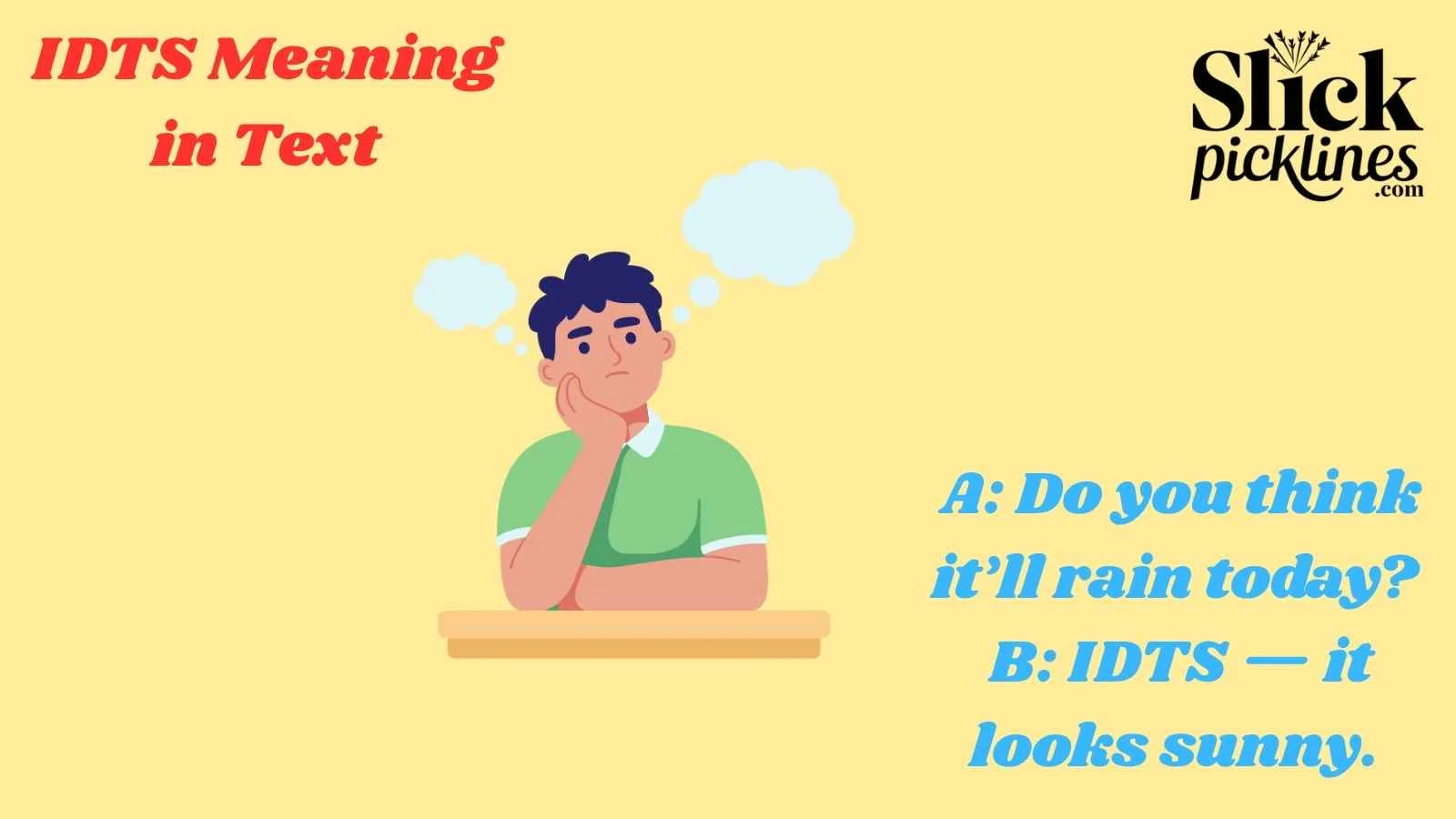Have you ever read a message that said “IDTS” and wondered what it means? 🤔 Don’t worry — you’re not alone!
With so many new abbreviations popping up every year, it’s easy to get lost in the language of texting.
In this guide, we’ll break down the IDTS meaning in text, how to use it correctly, and when not to use it. Let’s dive in! 🚀
What Does IDTS Mean in Text? 💡
The abbreviation IDTS stands for “I Don’t Think So.” It’s a quick and casual way to express doubt, disagreement, or uncertainty in digital conversations. Instead of typing out the full phrase, people simply use IDTS to respond faster — especially in texting, social media, or group chats.
💬 Example:
A: Do you think it’ll rain today? ☁️
B: IDTS — it looks sunny. 🌞
Simple, efficient, and to the point. That’s exactly how modern slang works in 2025! ⚡
Where Is IDTS Commonly Used? 📲
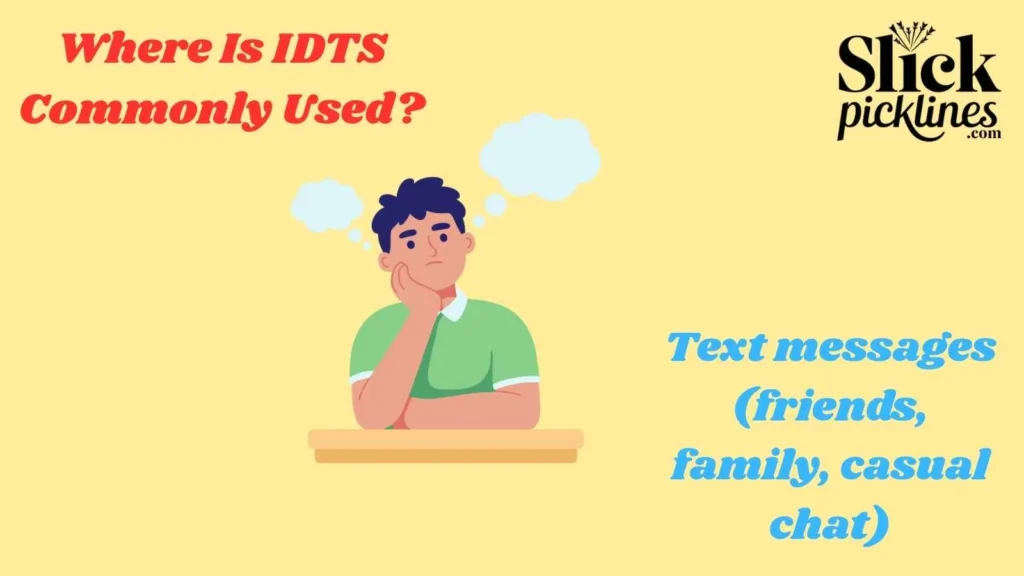
You’ll often see IDTS in:
- 💬 Text messages (friends, family, casual chat)
- 📱 Social media posts or comments
- 🧑💻 Online communities or gaming chats
- 💻 Group discussions or DMs
It’s part of a growing trend where users replace long sentences with short, snappy abbreviations that still carry tone and intent. IDTS is perfect for expressing polite skepticism without sounding harsh.
Understanding the Tone of IDTS 🎭
The tone behind IDTS can vary depending on how it’s used. Here are some common tones:
| Tone | Meaning | Example |
|---|---|---|
| Neutral | Simple disagreement | “IDTS, I just checked the weather.” |
| Playful | Light teasing or joking | “You think he likes her? IDTS 😂” |
| Confident | Firm disagreement | “IDTS — I’m sure that’s not right.” |
| Polite | Soft disagreement to avoid confrontation | “Hmm, IDTS but maybe we can double-check.” |
💡 Tip: IDTS is often followed by an explanation or emoji to soften the message — making it sound friendly rather than dismissive.
How to Use IDTS in Conversations 💬
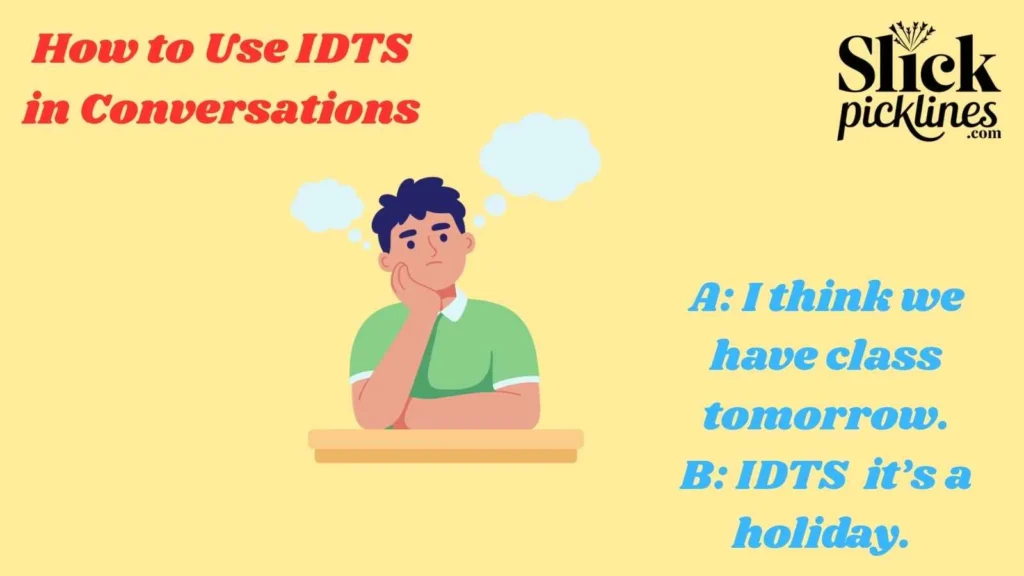
Let’s look at some real-world examples of how people use IDTS naturally in different scenarios:
Example 1:
A: I think we have class tomorrow.
B: IDTS — it’s a holiday. 🎉
Example 2:
A: Did she like your post?
B: IDTS, she didn’t react. 😅
Example 3:
A: That new app is free, right?
B: IDTS, I saw a price tag on it. 💸
As you can see, IDTS helps keep conversations casual, short, and expressive — exactly what digital communication thrives on. 💬
Similar Abbreviations to IDTS 🔠
| Abbreviation | Full Form | Meaning |
|---|---|---|
| IDK | I Don’t Know | Expressing uncertainty |
| IDC | I Don’t Care | Expressing indifference |
| IMO | In My Opinion | Sharing personal view |
| TBH | To Be Honest | Being straightforward |
| SMH | Shaking My Head | Expressing disbelief or disappointment |
All of these, including IDTS, help users communicate faster and more emotionally through short text bursts. ⚡
When Should You Use IDTS? ✅
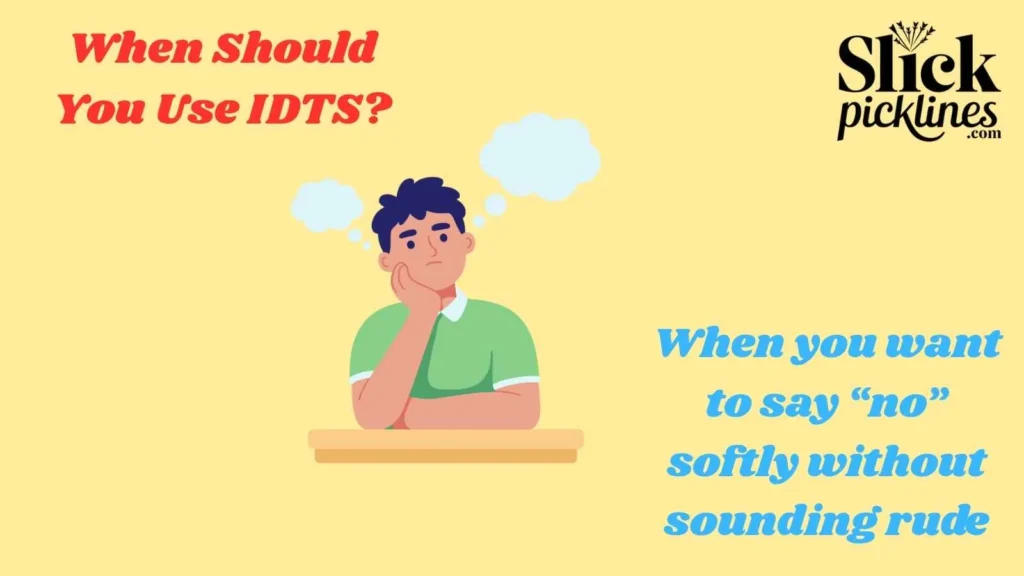
Use IDTS when you want to disagree politely, express doubt, or respond quickly in casual chat. Some good scenarios include:
- When you want to say “no” softly without sounding rude
- When you’re not completely sure but have a feeling something isn’t true
- When replying casually to friends or peers online
It’s not recommended for formal emails, academic writing, or workplace communication — it’s too informal for those contexts. 🚫
When NOT to Use IDTS ⚠️
- ❌ In professional or official messages
- ❌ When clarity is critical (use full phrases instead)
- ❌ In serious discussions where tone may be misunderstood
Since abbreviations can sometimes seem dismissive or vague, it’s better to spell out your full thoughts in sensitive situations.
How to Reply to IDTS 🗨️
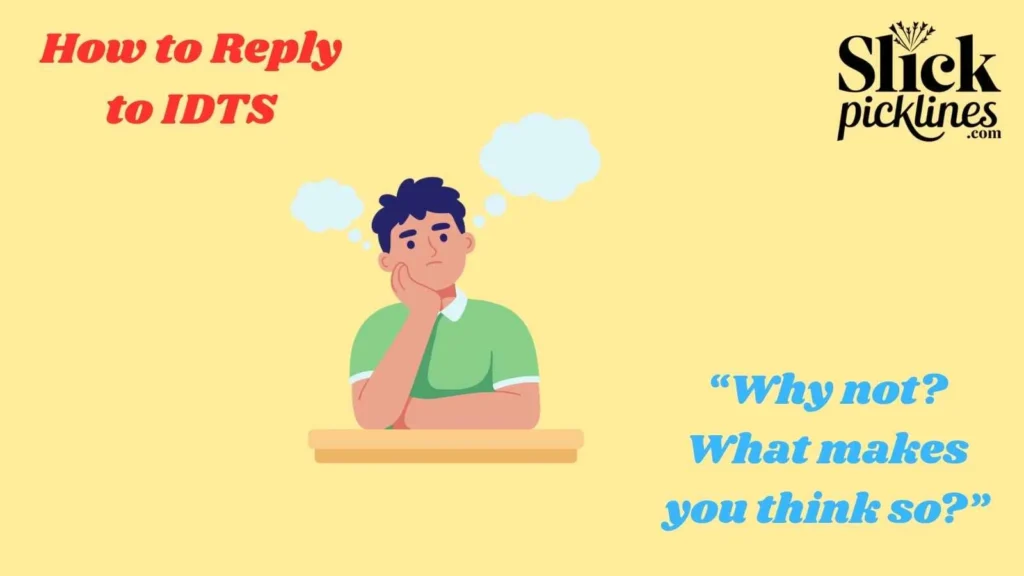
Wondering how to respond when someone texts you IDTS? Here are a few examples depending on the context:
- 👍 “Maybe you’re right!”
- 🤔 “Why not? What makes you think so?”
- 😅 “Haha, okay fine, maybe I was wrong.”
- 💬 “Alright, let’s check and see!”
Engage politely and with curiosity — texting is all about keeping conversations flowing naturally. 💫
Other Expansions or Misuses of IDTS 🤷♂️
Though rare, some users play around with acronyms online, giving IDTS funny or unrelated meanings. For instance:
- “I Did That Successfully” (humorous twist)
- “I Don’t Trust Someone” (context-specific use)
However, in mainstream texting and social media, “I Don’t Think So” remains the universal meaning of IDTS. ✅
Why People Prefer Using IDTS 🧠
Modern texters and social media users love abbreviations because they are:
- ⚡ Fast to type
- 📱 Easy to remember
- 😎 More expressive with fewer words
- 💬 Great for informal or playful communication
Abbreviations like IDTS reflect how language evolves with technology — creating new ways to express tone and attitude instantly. 🌐
Psychology Behind Using “I Don’t Think So” 💭
“I don’t think so” is a subtle way to disagree without confrontation. It communicates skepticism, confidence, and emotional control. When shortened to IDTS, it still carries those same vibes but sounds lighter and more conversational.
Common Mistakes with IDTS 🚫
- Assuming it means something else (stick to “I Don’t Think So”)
- Using it in formal messages (avoid slang in business contexts)
- Typing errors like “IDST” or “ITDS” — which can confuse readers
Make sure to keep your tone friendly and use emojis when appropriate to make your intent clear. 😊
Examples of IDTS in Social Media Posts 🌐
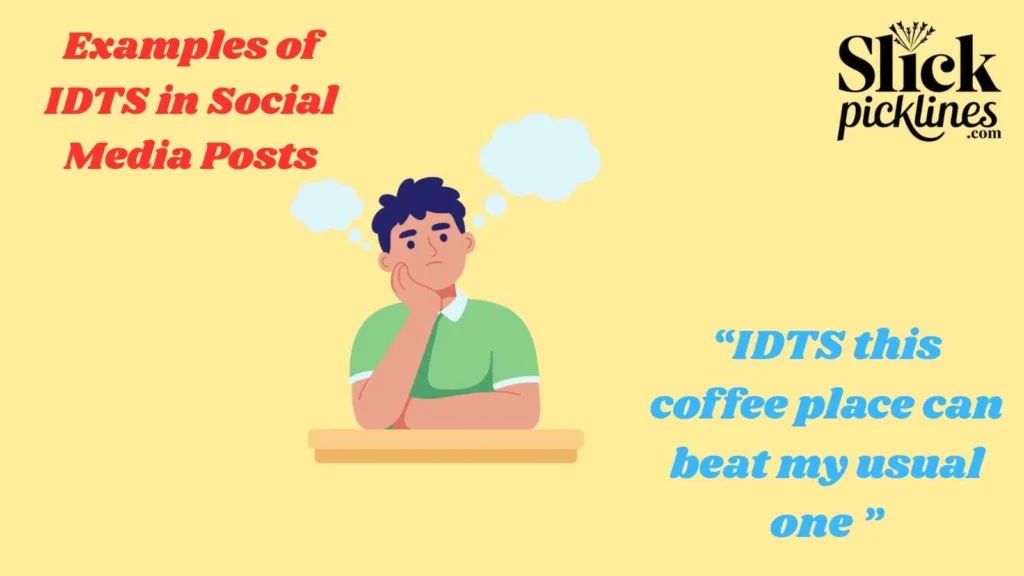
- “IDTS this coffee place can beat my usual one ☕😂”
- “He said he’ll text me back soon… IDTS tho 😅”
- “IDTS she meant that in a bad way 😇”
These examples show how flexible the acronym is — it works in humor, light disagreement, or even subtle sarcasm. 😏
FAQs:
1. What does IDTS stand for?
IDTS means “I Don’t Think So.” It’s used to express doubt, disagreement, or uncertainty in casual chat.
2. Is IDTS rude to use?
No — not if used politely. It’s casual, not confrontational. Add emojis to make your tone clearer. 😊
3. Is IDTS used in professional communication?
Not really. It’s informal slang meant for texting and social media, not work emails or reports.
4. What’s the difference between IDTS and IDK?
IDTS means “I Don’t Think So,” expressing doubt, while IDK means “I Don’t Know,” expressing uncertainty.
5. Are there other versions of IDTS?
Some people jokingly create variations like “I Don’t Trust Someone,” but those are not widely recognized. Stick with the main meaning. 👍
Key Takeaways 🗝️
- IDTS = “I Don’t Think So.”
- Used to politely disagree or express doubt.
- Common in texting, social media, and group chats.
- Not for formal or professional use.
- Helps keep messages short and casual. 💬
Conclusion:
The abbreviation IDTS is a perfect example of how digital language keeps evolving — short, expressive, and efficient.
Whether you’re texting a friend or commenting on social media, IDTS helps you communicate your opinion quickly without sounding harsh. 😌
So next time someone says something you politely disagree with, just drop an IDTS — and you’ve said it all. 💬

